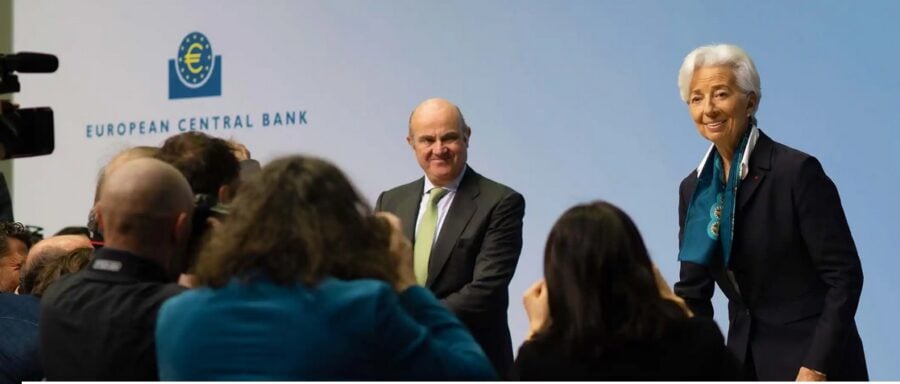As the European Central Bank (ECB) prepares Thursday to raise interest rates for the first time since 2011, policymakers hope to combat “fragmentation” in the eurozone, as the borrowing costs that members face begin to diverge.
This comes at a time when the situation in the Eurozone is becoming increasingly complex and is likely to deteriorate further. It is preparing for a winter that could see energy shortages, and plans to ration resources if Russia halts gas shipments to the continent.
Added to this is the decline of the euro, which fell below the level of one dollar for the first time in nearly 20 years, and the political crisis in Italy.
The political instability that threatens Italy’s former ECB chief Mario Draghi’s tenure as prime minister has exposed the challenges facing his former bank colleagues as they prepare to unveil historic policy changes this week.
The ECB policy maker, Olli Rehn, is likely to raise interest rates by 25 basis points on Thursday, and by 50 at the next meeting in September.
The deposit rate set by the ECB has been negative for the past eight years, while the key rate is now -0.5 percent. The bank has sought through this policy in the past to encourage banks to increase lending.
The interest rate hike comes in response to the unprecedented rise in prices spurred by disrupted supply chains and rising energy costs, following the Russo-Ukrainian war.
The inflation rate in the euro area reached 8.6 percent in June, the highest level in the history of the euro area. It is well above the target set by the European Central Bank of 2 percent.
The central bank had suspended its stimulus program to buy bonds since the beginning of July, with the announcement of its readiness to raise interest rates.
Reducing “fragmentation”
The rapidly increasing pressure in bond markets prompted the ECB to respond, at an emergency meeting in mid-June, by rushing to design an anti-fragmentation tool in the eurozone with details on this expected after Thursday’s meeting.
According to ECB officials, the new tool is necessary to avoid excessive variation in the borrowing costs faced by different countries, and to ensure that all eurozone member states are equally affected by monetary measures.
While eurozone members use the same currency, they do not share the same fiscal policy with the ultimate effect that as interest rates rise, the borrowing costs faced by different countries can begin to diverge.
This means that highly indebted countries in the currency club could end up paying a premium to investors, who see additional risks in any new borrowing.
This pressure in bond markets is measured by the “spread” or difference between the German debt yield – a measure of creditworthiness – and heavily indebted countries.
Why now?
The spread between German “bonds” and Italian government debt doubled from one percentage point to two in a few months, and rose after the previously scheduled meeting of the central bank at the beginning of June. Last week, the spread between the Italian 10-year bond yield and Germany’s yield rose to more than 2.22 percentage points, the highest level in a month.
This prompted the head of the bank, Christine Lagarde, to call an emergency meeting, after which it was announced that the bank’s employees were designing a tool to deal with the pressure of bonds, a move aimed at calming tensions. This is before the new political crisis in Italy created renewed concern among investors.
Mario Draghi submitted his resignation to the Italian President, who rejected it, against the backdrop of the cracking of his ruling coalition after the “Five Star Movement” boycotted a vote of confidence, which plunged Italy into a political crisis and put it in front of the possibility of organizing early general elections.
Analysts say that the Italian debt is the biggest headache at the moment for the EU countries, because of its huge size and the high value of its service amid energy crises that hit the Italian economy and the increase in its budget deficit.
According to Leslie Lipschitz, former director of the International Monetary Fund’s Center for Economic Studies, the Italian debt threatens to trigger a financial crisis in the eurozone.
The Italian debt is currently approaching $3 trillion, or 150 percent of Italy’s GDP.
The Italian debt market is the largest in Europe, and the Italian economy is the third largest in the European bloc.
Why is the ECB concerned?
In the eyes of the European Central Bank, retail is preventing all members of the Eurozone from feeling the effects of its monetary policy moves.
Higher yields in Italy could mean that a company or family in Rome may have much higher borrowing costs than those in Berlin, even if they have the same risks.
But the ECB’s plan to tackle retail bond markets in the eurozone was met with lukewarm acceptance among officials in Nordic countries such as Germany, Austria and the Netherlands.
They worry that the ECB is overreacting as bond markets adjust to higher interest rates. In an effort to keep borrowing costs low for heavily indebted countries, they fear the central bank will encourage fiscal laxity and may shy away from “cash financing” of governments, which is inconsistent with the EU treaty.








